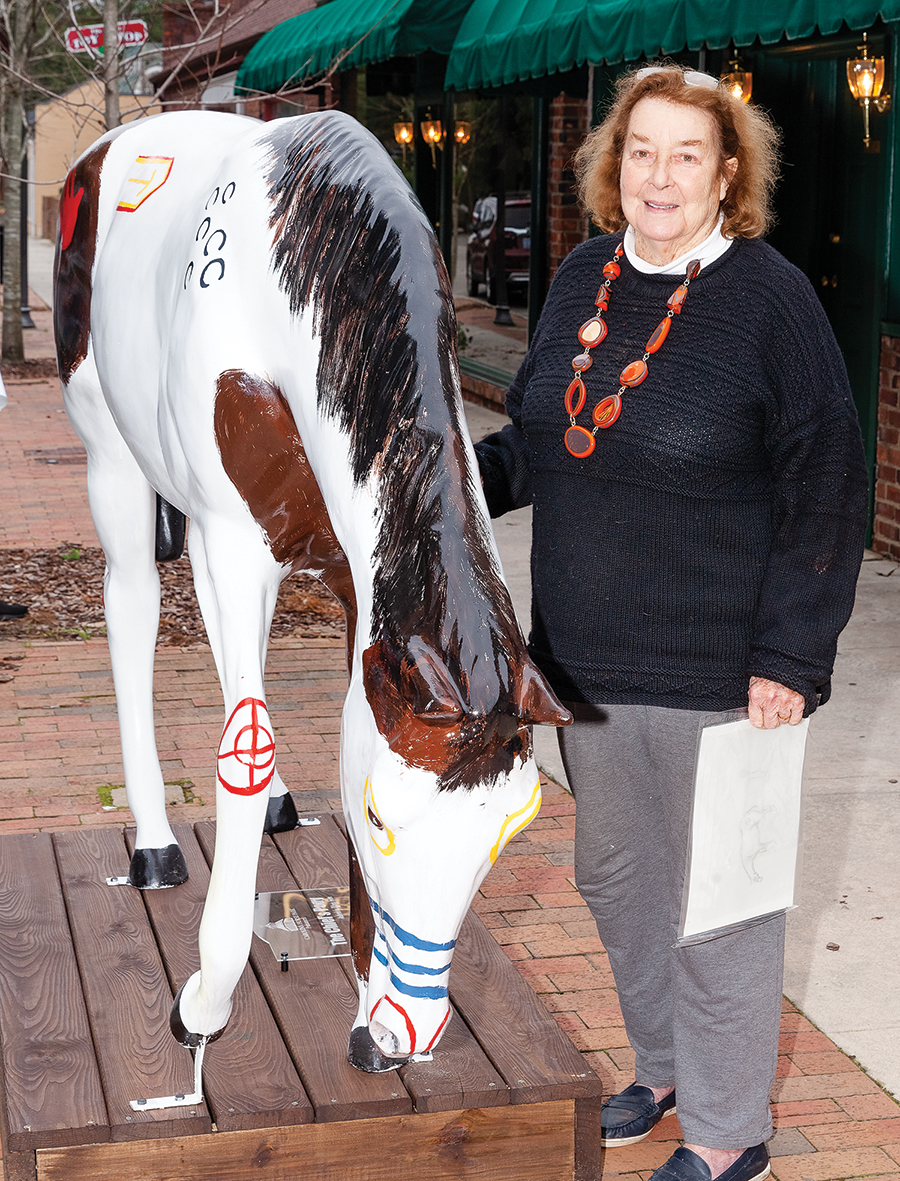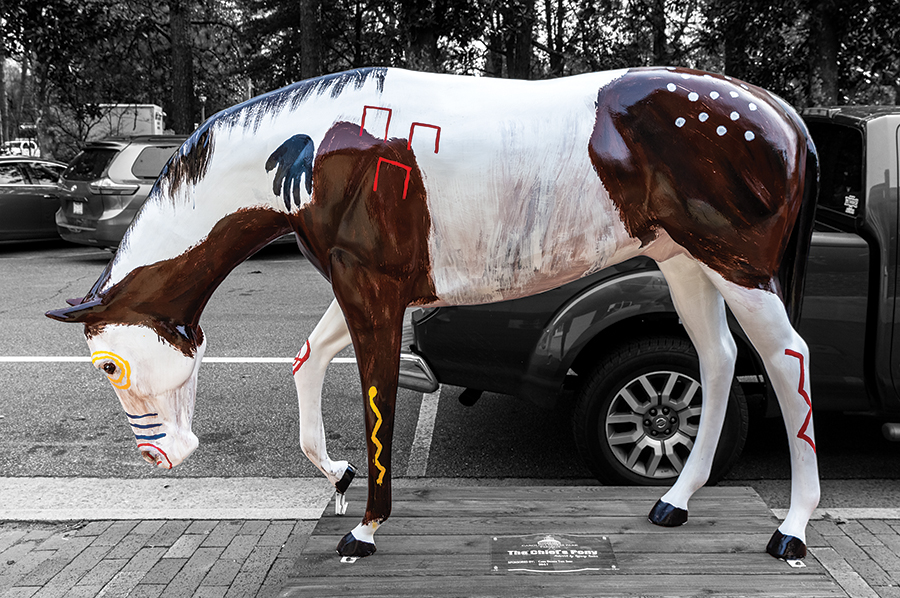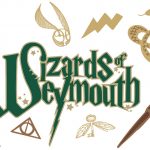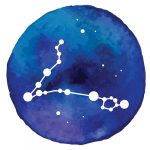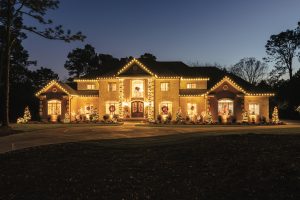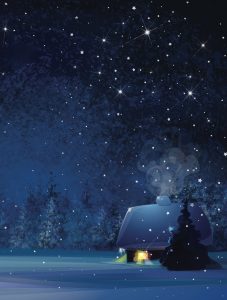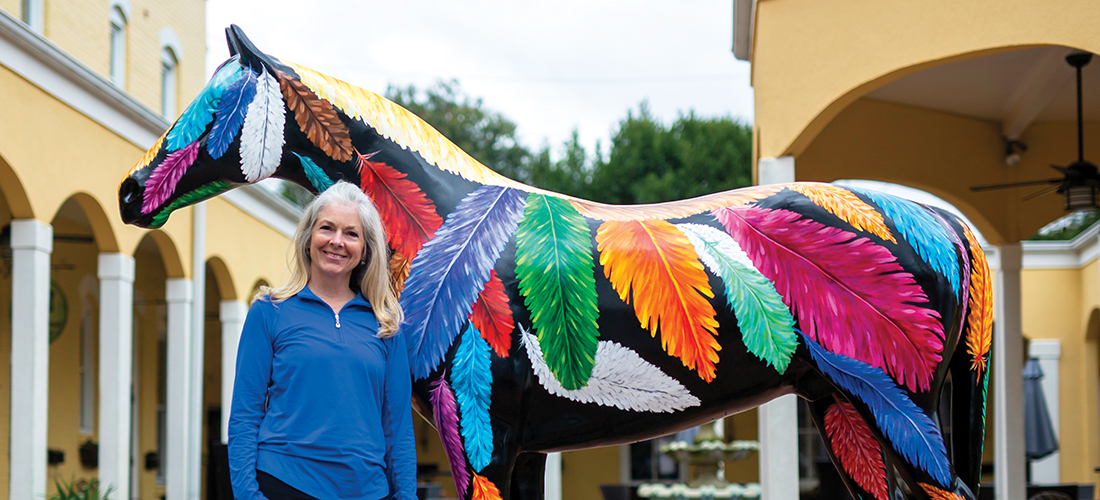
A new breed of pony in the Pines
By Jenna Biter • Photograph by Tim Sayer and John Koob Gessner
Southern Pines recently gained a handful of new temporary residents, 10 painted ponies courtesy of a fundraiser for the Carolina Horse Park, a charitable nonprofit corporation committed to the upkeep of grounds for equestrian and recreational use. Located in Hoke County, the 315-acre park is a nationally recognized equestrian competition site, and it’s a horse lover’s paradise.
Now, the painted ponies of Southern Pines may not be living and breathing animals, but they’re the next best thing: life-size lookalikes painted by local artists and sponsored by local businesses. Together, each artist and sponsor(s) brainstormed and, ultimately, chose a theme for the artist to execute on the blank canvas of fiberglass horseflesh. And boy, did they execute.
The themes run the gamut from a sporting art take on life in the Pines to an impressionistic rendering inspired by Van Gogh’s Starry Night. One pony even has a three-dimensional copper horn and wings, transforming it from equine into magical alicorn – but more on that later. At Big Sky Farm, on April 4, the painted ponies will be auctioned off to their permanent owners with all proceeds going to the Carolina Horse Park, so admire them downtown before March slips by. First, sneak a peek here.
Water for Horses
Artist: Jenay Jarvis
Sponsor: The Country Bookshop
“I love nature and creativity and have a very real passion for impressionism, which has fueled my love of painting,” says Jenay Jarvis, who studied fine arts at the University of North Carolina Asheville. “I specifically used Starry Night to inspire this piece,” she adds, referencing her painted pony Water for Horses.
Vincent van Gogh painted Starry Night, possibly his most recognized work, in 1889 during his time at the asylum of Saint-Paul-de-Mausole in France. Despite his tragically short life of only 37 years, van Gogh produced over 2,000 works — most of them in his last two years. Ever since, artists like Jarvis have looked to this master.
“I like my work to appear like the images in my mind: dreamy and surreal with a focus on color and movement,” she explains. “My work is fluid and often associated with water.” Although Starry Night doesn’t feature water, the blue and swirling sky makes the leap easy.
“Water itself could represent a number of things,” Jarvis continues. “It’s an open interpretation as with all art, and I’d like to leave that up to the viewer.” Regardless of how you interpret the work, from a distance, you can spot its famous inspiration, but take a closer look, and you’ll see Water for Horses come into its own.
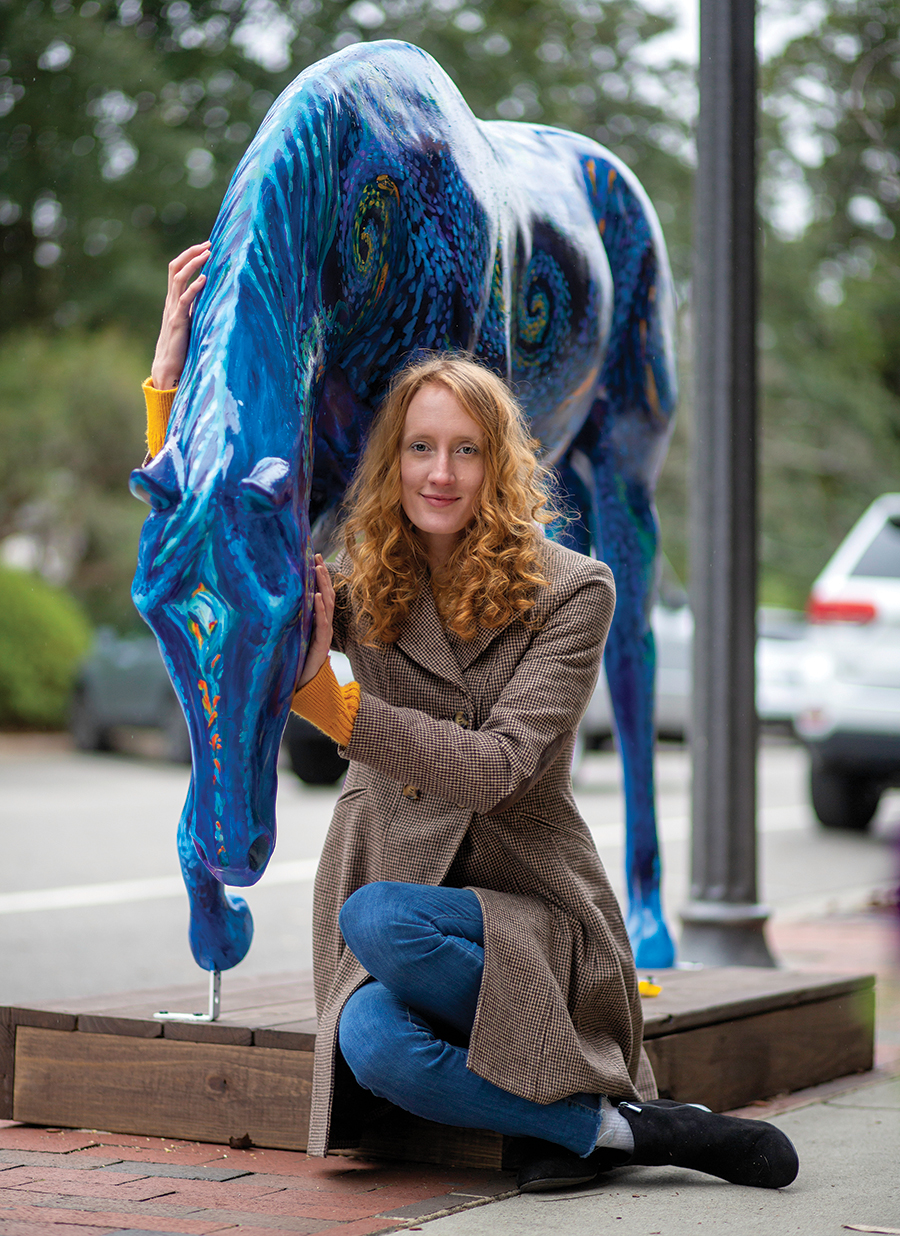
Love Your Local
Artist: Ashley Van Camp
Sponsor: Ashten’s Restaurant and Moore Equine Feed and Pet Supply
Ashley Van Camp, owner and chef of Ashten’s Restaurant, didn’t study visual arts in college, but she says, “I’ve spent a lot of time around food being a chef, so I think that’s helping me with our (artwork’s) theme, which is all about keeping it local.” Local food and local business. Appropriately, her painted pony’s name is Love Your Local…although, for those who know him well, he prefers to go by Lyle. Donning a Technicolor coat of produce, he pays homage to small businesses, specifically his sponsors Ashten’s Restaurant and Moore Equine Feed and Pet Supply.
“The things that our businesses have in common are that they are locally owned, and we both provide sustenance — she to horses and me to people,” says Van Camp of Moore Equine and her own restaurant. Lyle is the hypothetical offspring of these livelihoods. He sports ripened watermelons, an assortment of shiny red and green tomatoes, leafy purple cabbage, dainty flowers climbing his forelegs, and a carrot for a marking on his forehead. He’s a well-bred stallion foaled by small town love and sired by local abundance, Van Camp explains, and his artwork reflects his parentage.
While Ashten’s restaurant and Moore Equine Feed and Pet Supply nourish the stomachs of our Sandhills community, Lyle feeds our eyes with a visual feast. If he could see himself, he’d be drooling.
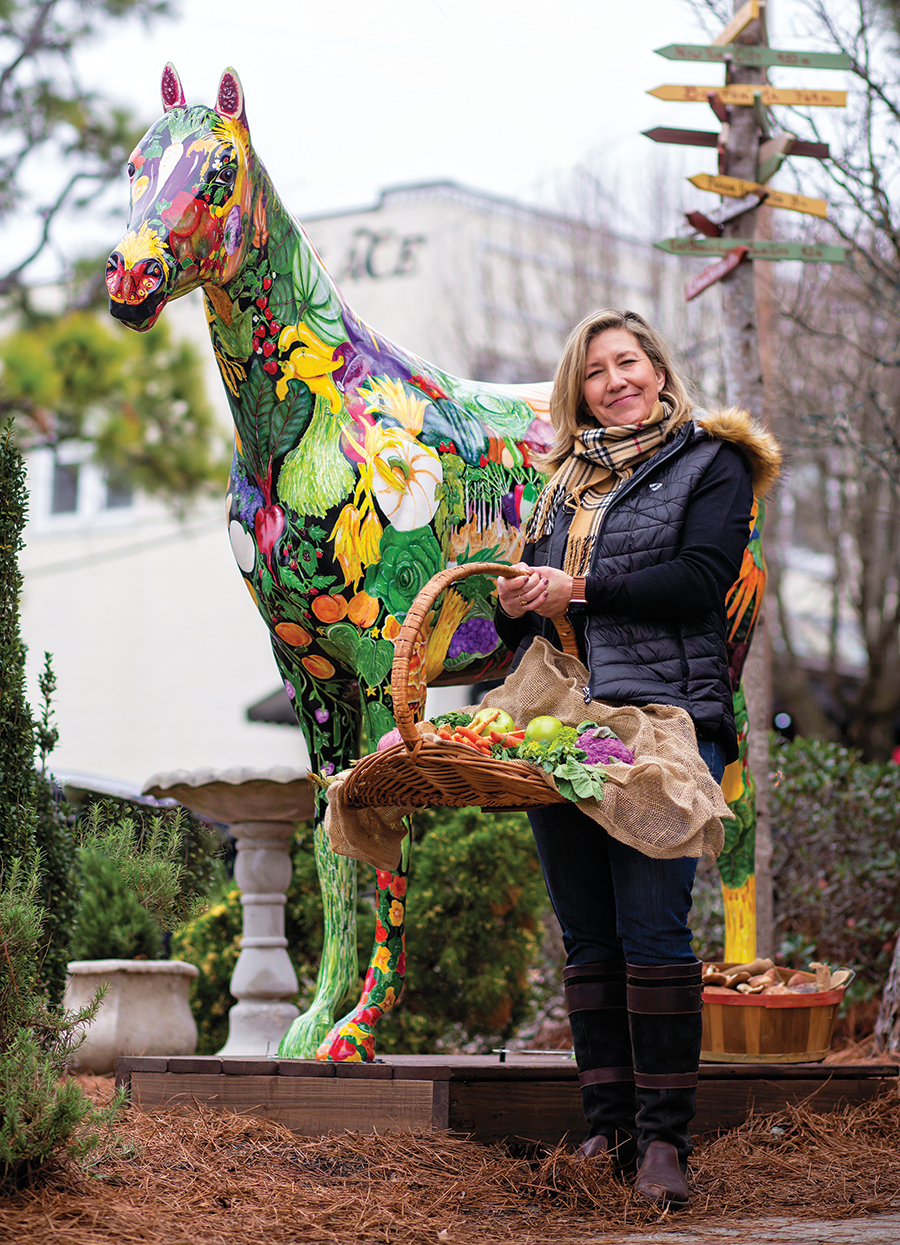
Horsefeathers
Artist: Beth E. Roy
Sponsors: Hampton Inn & Suites, TownePlace Suites and Hilton Garden Inn
Lewis Carroll didn’t let reality stop him from transporting Alice down the rabbit hole, and J.K. Rowling didn’t let it stop her from inventing a boy wizard to defeat the also invented He-Who-Must-Not-Be-Named (But-We’ll-Name-Him-Anyway) Voldemort. Fantasy writers and children have that in common; they don’t let reality stop them from creating. Regular old adults shouldn’t either: Beth E. Roy definitely hasn’t.
“My mother would not swear but used colorful words put together. When she expressed herself by saying, ‘Oh, horsefeathers,’ I had a vision of a horse covered in beautiful feathers,” says Roy of a childhood memory. And that’s how we got her painted pony, the imagination of a child brought to life by an adult — a very skilled adult. Professionally trained at Austin Peay State University and Christopher Newport College, Roy painted as a watercolorist for 15 years before moving to Southern Pines and taking up oils in the early 2000s.
She’s traveled to Italy and Mexico among other locales to participate in artist workshops, and she’s completed many commissioned works. Her art hangs in several galleries, and her painted pony Horsefeathers currently stands at Belvedere Courtyard in downtown Southern Pines. Its plumage of celadon, ivory, fiery orange and more lay against a black background that makes the colors buzz, causing us to wonder, is it about to take flight?
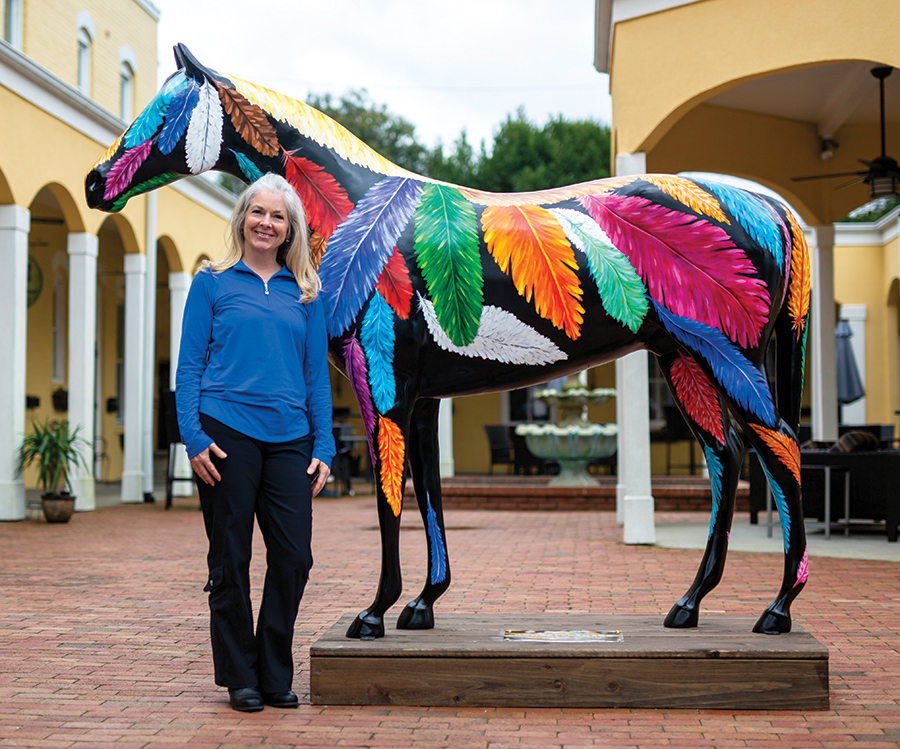
“Dream Big,” says the Alicorn
Artist: Nikki Lienhard
Sponsors: Better Homes and Gardens Lifestyle Property Partners, Opulence of Southern Pines and Patricia
“I was struggling with a design concept,” says graphic designer Nikki Lienhard of her painted pony. Until one day her 9-year-old daughter, Jesse, suggested over dinner, “Why don’t you do an alicorn?” Reflexively, Lienhard and her husband replied, “What the heck is an alicorn?”
“It’s a Pegasus with a horn,” Jesse informed them. And, although the term “alicorn” historically refers to the horn of a unicorn, Jesse is right. The kids’ TV show My Little Pony: Friendship is Magic and other media have culturally popularized the alicorn as a winged unicorn. Sometimes, pegacorn or unipeg are terms referring to this magical ungulate, while other times, it goes entirely unnamed. But regardless of the creature’s name or lack thereof, it’s the crossbreed of two storied legends: Pegasus and the unicorn.
According to Greek mythology, Poseidon, the god of the sea, and Medusa, the mortal woman with snakes for hair and a face that turns men to stone, parent Pegasus. After the hero Perseus beheads Medusa, Pegasus and his brother Chryasor are born into the world from their mother’s severed head — what an entrance. On the other hand, the Greeks classified unicorns not as mythology but as natural history; they believed the animals lived in India.
But back to Lienhard: “Before I knew it, I was creating this magical alicorn with copper wings and a horn, something right out of a fairytale.” Right out of a fairytale and into the Sandhills.
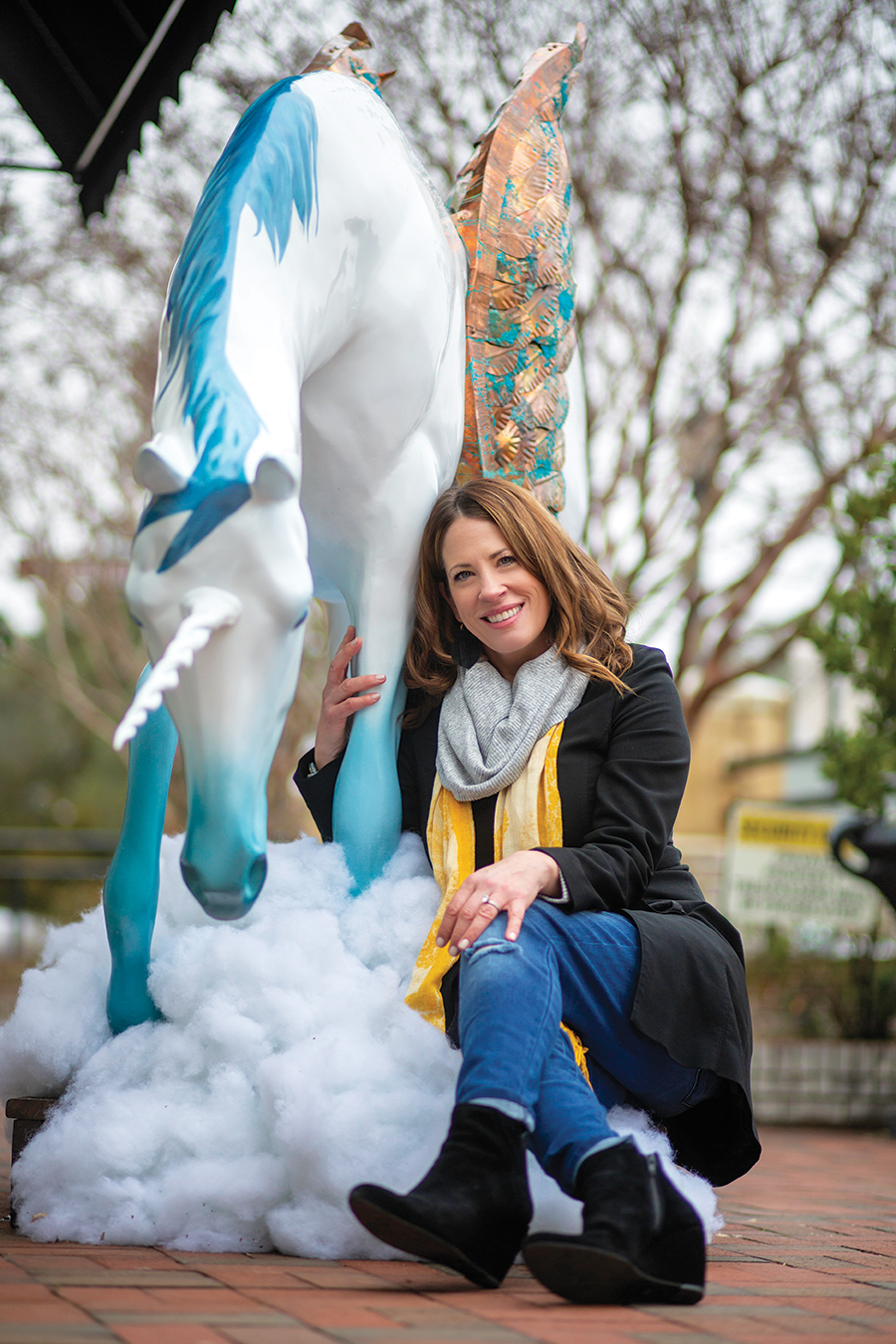
Royal Tashunka
Artist: Mary Ann Welsch
Sponsor: WhitLauter by Leann Parker
Mary Ann Welsch and her painted pony’s sponsor are a match made in horsey heaven. “I found out that my sponsor was WhitLauter (Estate Jewelry), so I went down to introduce myself. I started looking at all the beautiful jewelry, and I thought, where does the concept of jewelry come from? How long has it been around?” says Welsch.
Turns out, it’s been around for 135,000 years, provable by a necklace made of eagle talons. A little odd, no? But a different ancient necklace inspired Welsch: a 40,000-year-old Kenyan piece made of ostrich eggshells. “The women actually still do it. Like a little puka bead, they take that shell and then crush it up into small pieces and make jewelry out of it,” she explains, pointing at the eggshell beads painted on her pony’s back. Combine these beads with gems, succulents, horse tack and a little bit o’ the Southwest — all on the canvas of a tobiano pony — and, voila, it’s Royal Tashunka.
Fun fact: Tashunka is the Siouan word for horse. Thanks to Welsch’s attention to detail in both research and artistic execution, her painted pony’s disparate components (see succulents and horse tack) meld into a cohesive whole that feels new. Corroborating this take, Welsch comments, “I like to make things that don’t exist.”
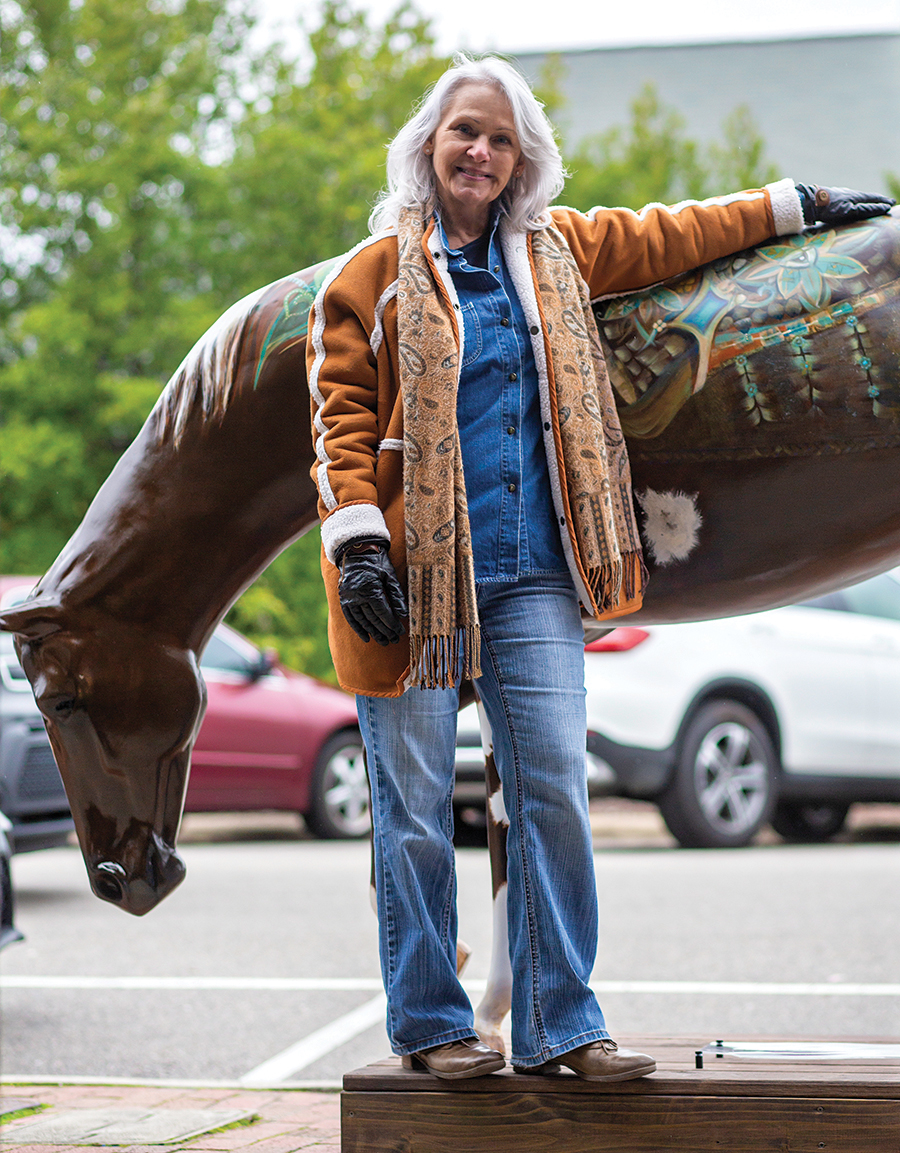
Living in the Pines
Artist: Gene Fletcher
Sponsor: The Pilot
British sporting art is exactly what it sounds like: artwork that depicts British sport. This eventually includes sports like cricket and boxing, but originally, it meant country pursuits like fishing, foxhunting and horse racing. Gene Fletcher is a fan of the originals.
“I’ve always been really attracted to the British sporting artists. The 18th century, 19th century sporting artists — they’re the ones I really admire, so this was kind of natural,” says Fletcher, pointing to his painted pony, Living in the Pines. One flank shows two horses at pasture, while the other shows a mounted hunt complete with two hounds and a fox. Purple mountains and a blue sky provide the backdrop for both scenes. “Of course, the fox didn’t get captured,” Fletcher jests. “He’s looking (and) saying, ‘Ha-ha, you missed me, right?’”
The victorious fox peers at huntsman & co. from behind a tree papered with a flier that reads, “The Pilot 100 years.” The detail is a nod to the artwork’s sponsor and its centennial anniversary. A flowering dogwood and cardinal grace the neck of the painted pony as homage to the North Carolina state flower and bird.
Fletcher’s work, in a snapshot, shows the tradition of the Sandhills through a mostly equestrian lens. And it makes sense. Horses are significant to the area and, lucky for Fletcher, “In 30 seconds or less, I can draw a horse,” he quips.

Little Red Truck
Artist: Claire Connaghan
Sponsor: McDevitt Town & Country Properties
Rising to prominence in the 1950s, pop art rejected fine art and embraced the commonplace: advertisements, comic strips, and objects like Campbell’s tomato soup cans and Brillo boxes. Critics tut-tutted the movement, but the general population adored its rebuff to the art world’s members-only vibe, catapulting artists like Andy Warhol and Roy Lichtenstein into the limelight. Claire Connaghan’s Little Red Truck is reminiscent of this 20th century movement.
“I chose to keep a simple and colorful illustration style with a little country scene and a little red truck in the middle,” says the 25-year-old graphic designer. Her edited design, flat application of color and black outlines combine for a cheery and approachable work. The upper half of the pony is an unshaded blue sky spattered with cartoonish white clouds, while the lower half is a solid grassy foreground. Smack dab in the middle of the left flank is a little red truck, the heart and soul of her sponsor, McDevitt Town & Country Properties. Jamie McDevitt, owner of her eponymous business, once had a red truck, and made it her logo. Then, the truck moved on, and her logo changed, but the vehicle is still at the core of her business.
With that big, blue sky consuming half of her pony, Connaghan’s interpretation of the McDevitt icon is a breath of fresh air.
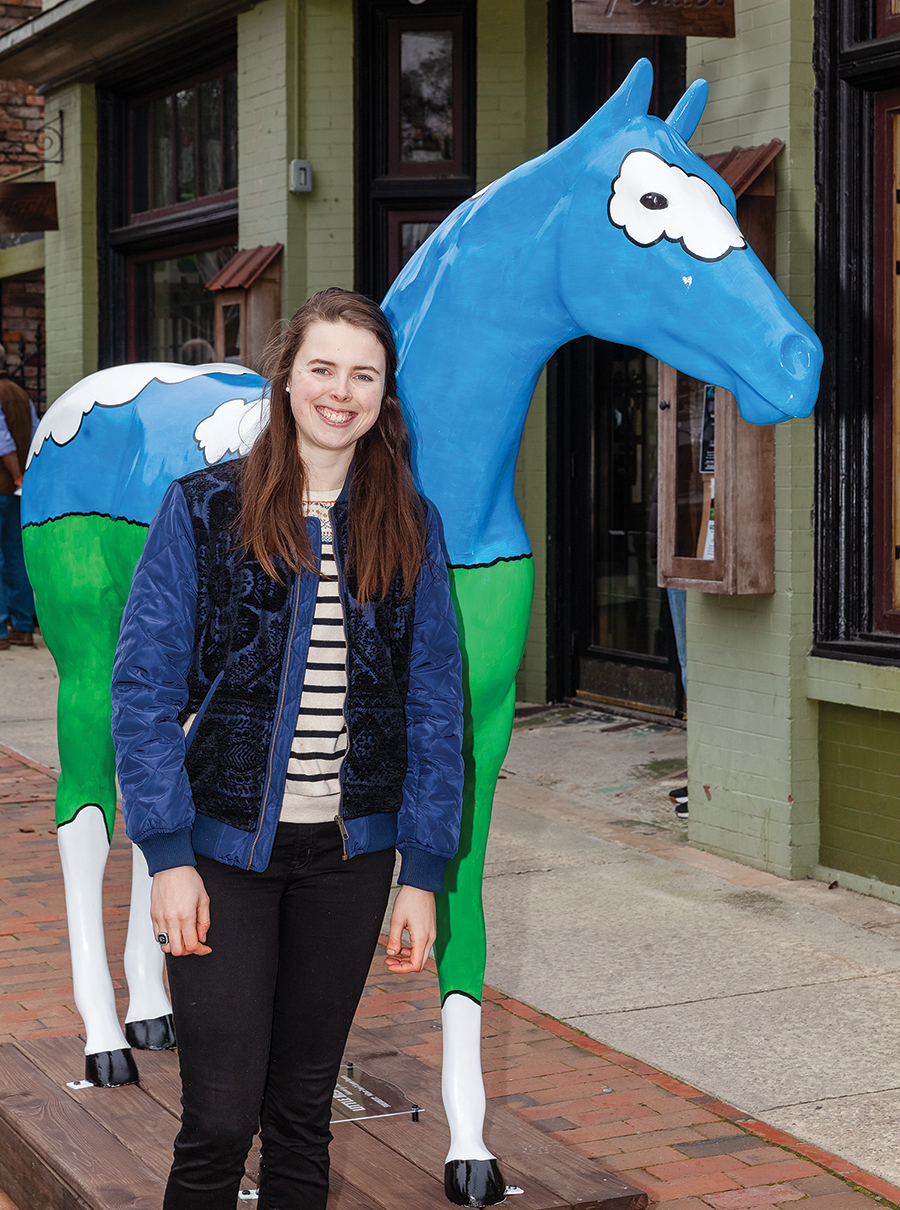

Horses Connect Us All
Artist: Shelly Turner
Sponsors: Pinnock Real Estate & Relocation Services, C.Cups Cupcakery and Longevity Massage & Bodywork Therapy Center
Although horses appeared in cave art 30,000 years ago, their domestication (the genetic reorganization that took them from wild animal to pet) didn’t come until later — and that date is hotly debated. Most researchers agree that equine domestication happened around 2,000 BC at the latest, but some claim it occurred over 1,000 years earlier. The exact date isn’t the point. It’s that the human-horse relationship is long, notable and indivisible from history.
“From farming to military, pleasure to show, therapy work to pasture pet, horses have been and continue to be such an important, integral element in the world,” says Shelly Turner, owner of and interior designer at Canter Lane Interiors. “Think of just about any topic and horses can be linked.” Even the Carolina Horse Park’s fundraiser proves Turner correct, validating her artwork’s title, Horses Connect Us All.
“With his head to the ground, he seemingly breathes in the world around him,” she says of her painted pony. “I (expressed) this notion by painting the soil from his muzzle to cheeks and showing plant roots that bloom into a colorful palette of local elements.” These elements include agriculture, golf and the military painted in a style visually similar to that of a 19th century American quilt.
Turner concludes, “I think that my upbringing and love for folk art, animation and tribal embellishment and design combined to inspire and create this eclectic piece.”
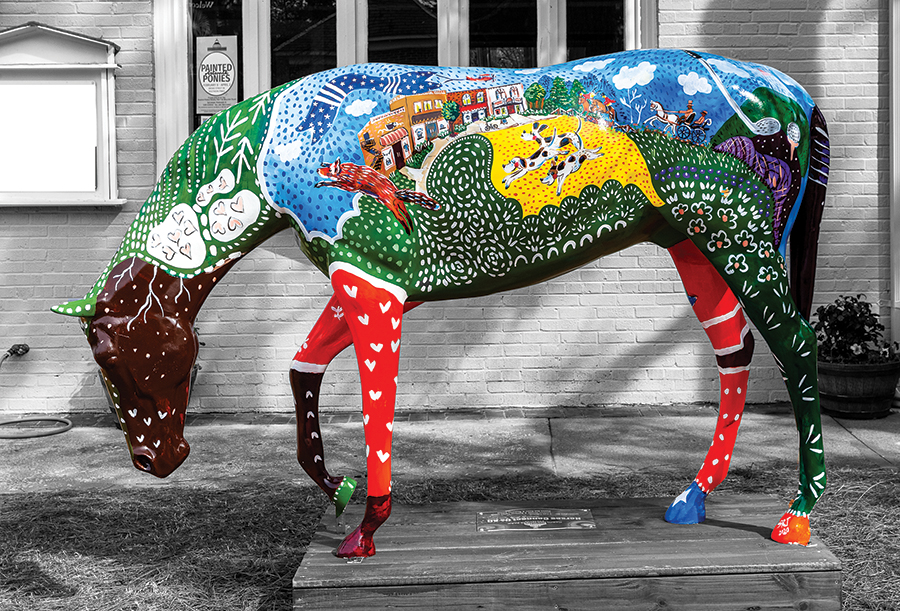
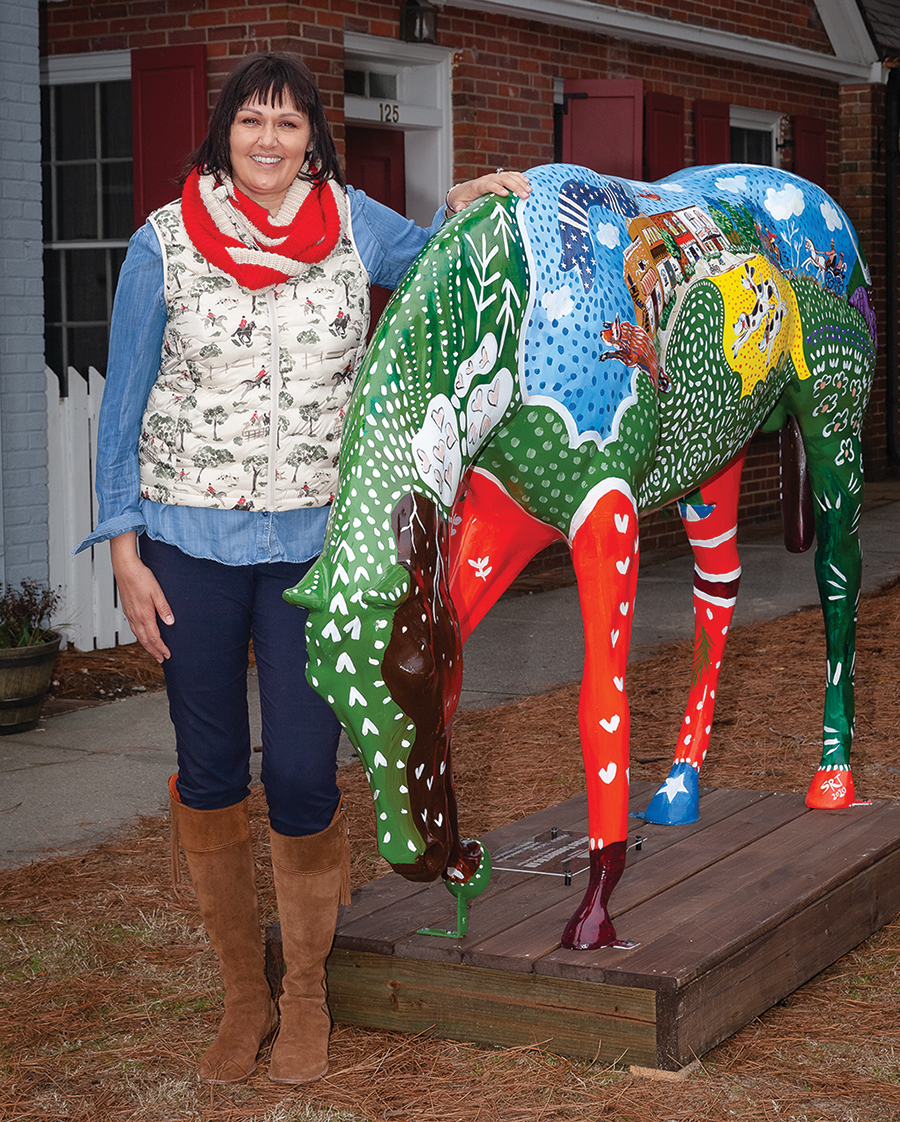
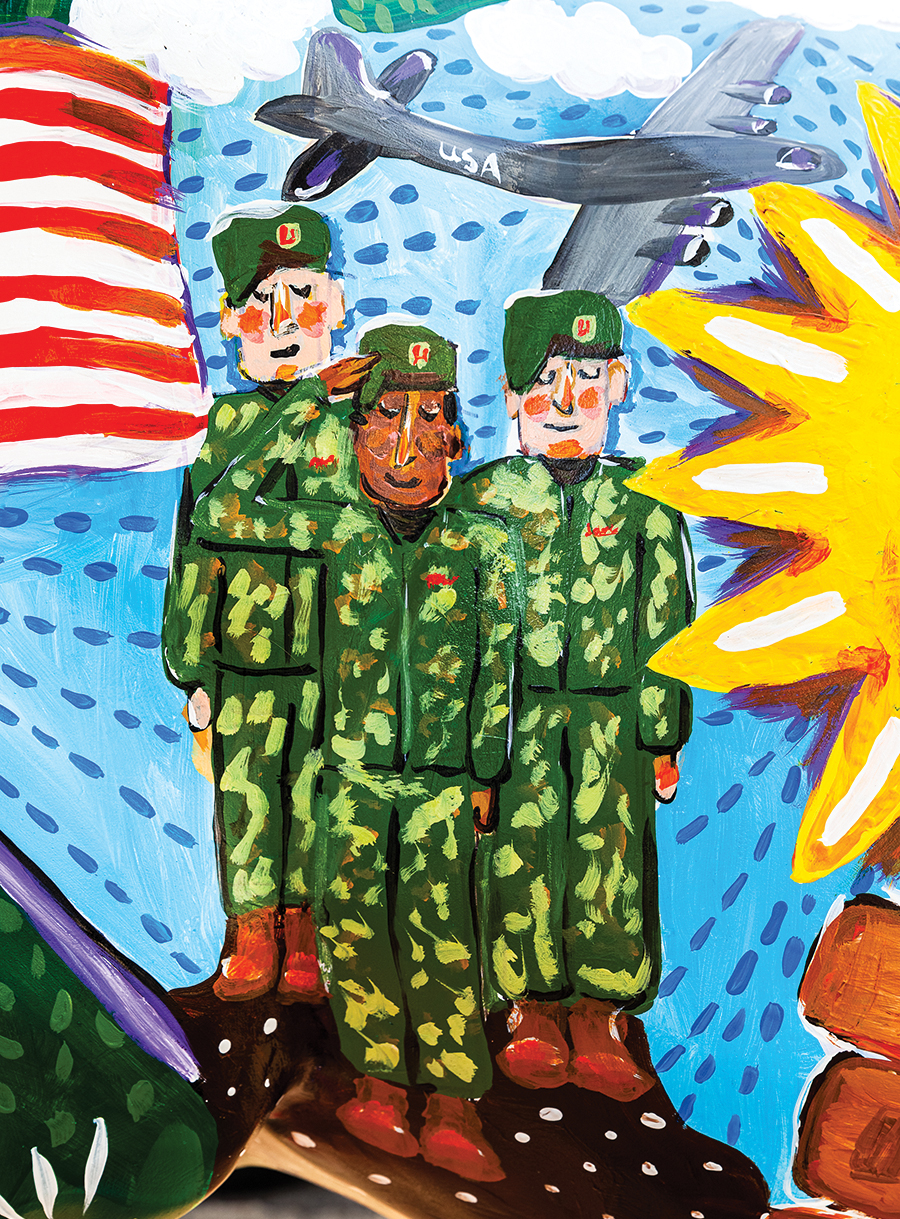
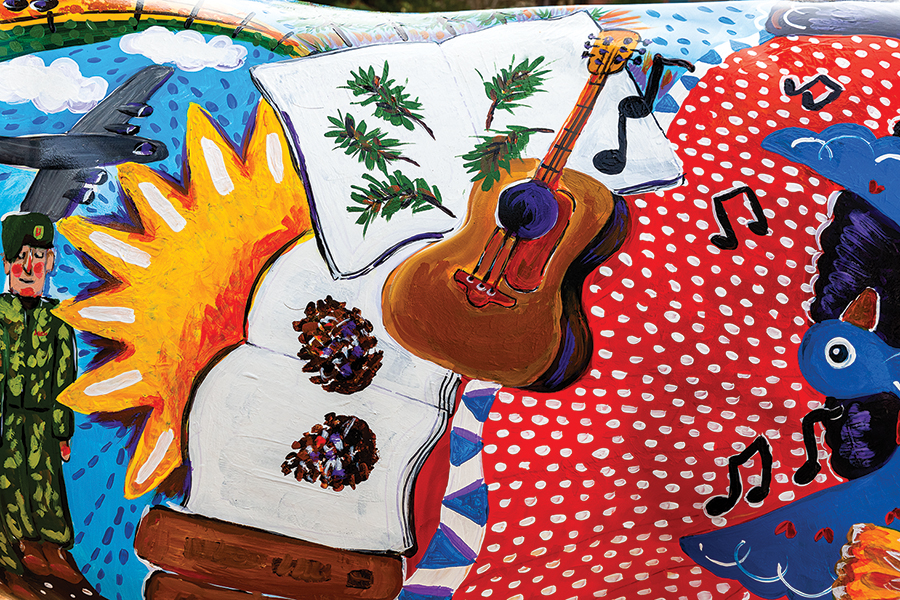
Between the Ears
Artist: Darlene Ivey
Sponsor: English Riding Supply
“My mom is an artist; she taught me how to draw, and I’ve always been into horses, so that’s what I learned to draw,” says Darlene Ivey. Thankfully, she had plenty of support that helped to take her artwork far. When Ivey was in high school, her dad encouraged her to make and sell paintings. This eventually led to commissions. Roll all of that together, and that’s how Ivey ended up here: an equestrian apparel rep and the artist of Between the Ears.
Her painted pony is the merger of the horses in her life; they’re joined into a sort of visual equestrian calendar, consisting of four tableaus, one for each season. The winter scene shows a lakeside horse ride, while the spring is a glimpse into horse show season. Summer is a ride on the beach that ultimately ends up in the ocean waves and, on this, Ivey comments, “A lot of horse people don’t ride on vacation, but I always try to.” The fourth and final scene represents fall, and it depicts the treasured foxhunts of Moore County. All four tableaus come from photographs Ivey has taken, and they’re layered over a palomino background.
Ivey elaborates on the horse at the center of it all, “My palomino Lacey was my childhood horse. My dad got her when she was 3, and she passed at 26. Most of my life she was with me.” Thanks to Between the Ears her spirit still is.
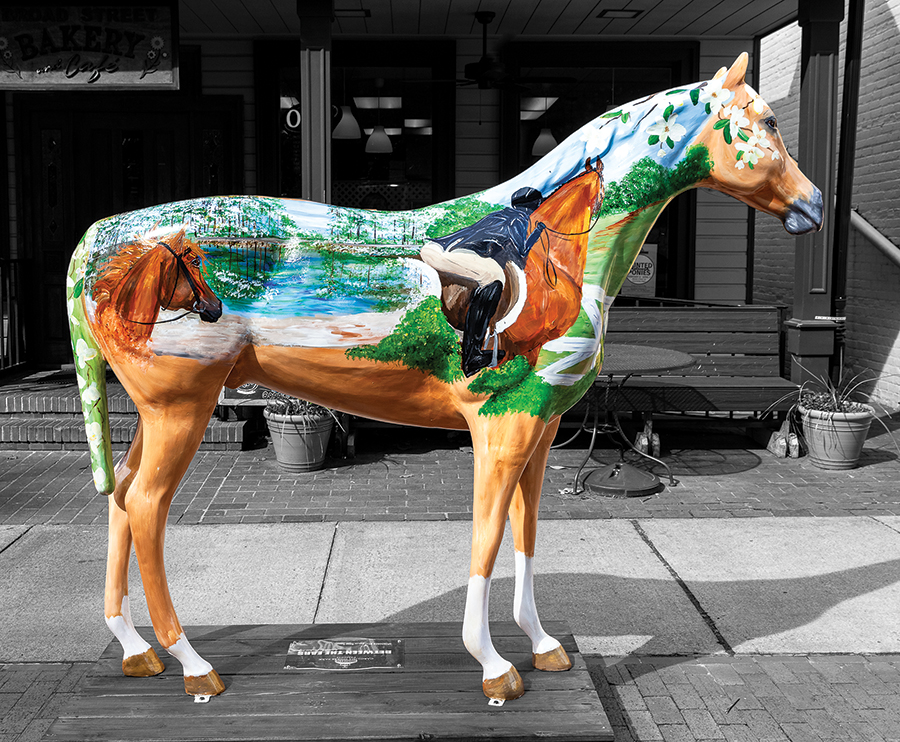
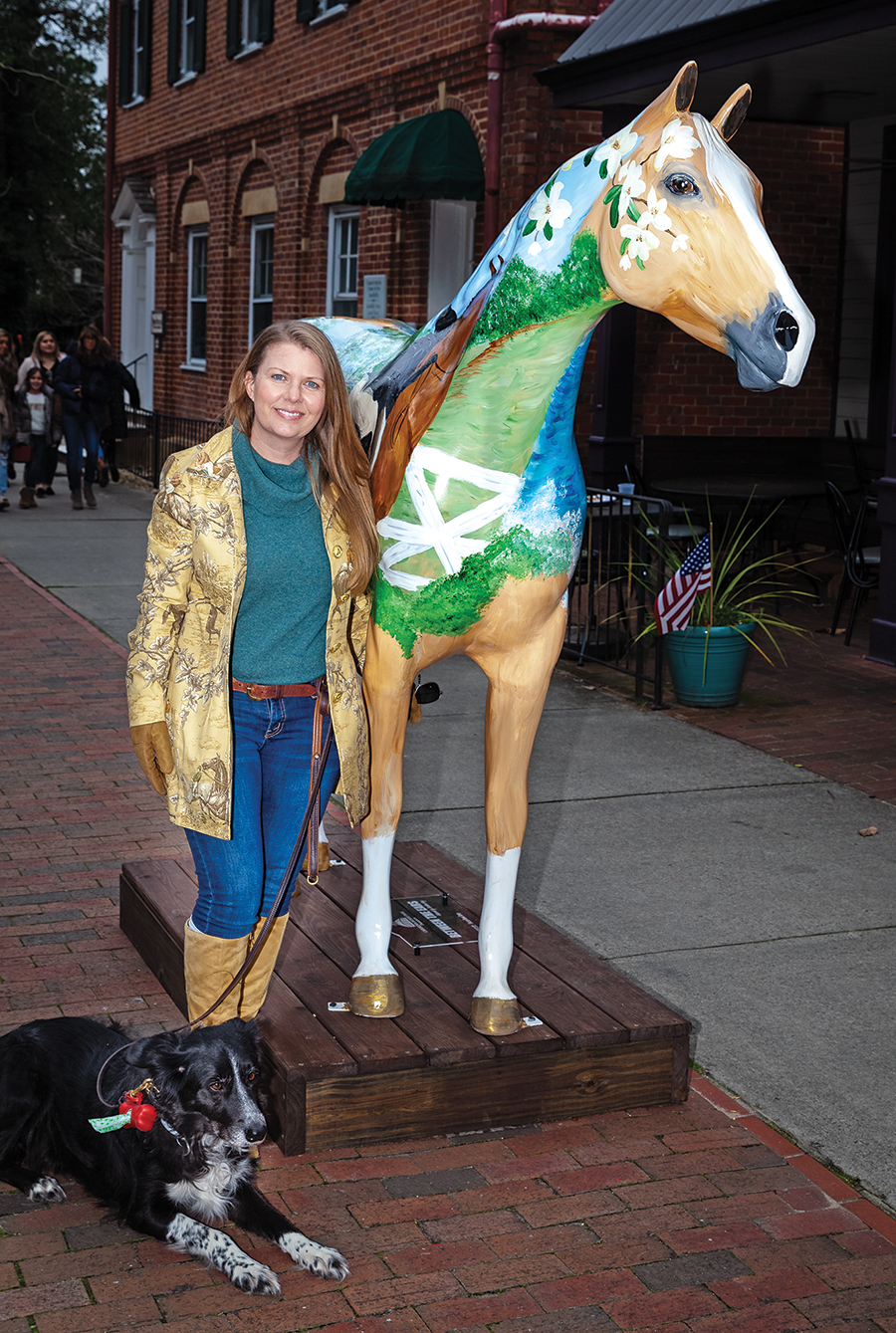
The Chief’s Pony
Artist: Tiffany Teeter
Sponsors: Cabin Branch Tack Shop and BB&T
“When I was a kid, you know, I was sure every Christmas I was going to get a pony, but my father said, ‘Listen, there’s six of you kids, if you want a horse you got to go buy it.’ I saved up my money, and I did: $85,” says Tiffany Teeter. That $85 led to foxhunting, a barnful of 65 horses at any given time (two of them Olympians), and a son who competed as a steeplechase jockey. It’s no surprise that now, with only one 23-year-old horse left, Teeter gets her equestrian fix elsewhere — painting a life-size doppelganger called The Chief’s Pony. He’s inspired by Native American warhorses.
“It’s what you call a medicine hat pony. You see the markings on his head?” asks Teeter, pointing to her pinto’s mostly white face. “Only the chiefs were allowed to ride that marking.” Only the chiefs and other powerful figures like medicine men and great warriors. Any pinto with an all-white head, except for its poll and ears, is a medicine hat pony, but the most beloved only had these markings. Add blue eyes, and it was even more revered. Because of their rarity, these ponies were thought to be good luck, able to prevent the deaths of their riders.
Referring to primary-colored symbols on her artwork, Teeter continues, “All these markings mean something. That means danger, those are captured ponies and this means may hail fall on your enemy . . . I like that one.” PS
